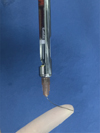1. Malamed SF. Handbook of Local Anesthesia. 5th ed. St Louis: Mosby;2004.
2. Sierra Rebolledo A, Delgado Molina E, Berini Aytís L, Gay Escoda C. Comparative study of the anesthetic efficacy of 4% articaine versus 2% lidocaine in inferior alveolar nerve block during surgical extraction of impacted lower third molars. Med Oral Pathol Oral Cir Bucal. 2007; 12:E139–E144.
3. Im TY, Hwang KG, Park CJ, Kim KS, Oh Y, Han JY, Shim KS. Randomized, Double-blind, Comparative Clinical Trial on the Efficacy of 4% Articaine and 2% Lidocaine in Inferior Alveolar Nerve Block Anesthesia. J Korean Dent Soc Anesthesiol. 2010; 10:1–6.

4. Altun O, Miloglu O, Dedeoglu N, Duman SB, Torenek K. Evaluation of localization of mandibular foramen in patients with mandibular third molar teeth using cbct. Folia Morphol (Warsz). 2018; DOI:
10.5603/FM.a2018.0044.

5. Thangavelu K, Kannan R, Kumar NS, Rethish E, Sabitha S, Sayeeganesh N. Significance of localization of mandibular foramen in an inferior alveolar nerve block. J Nat Sci Biol Med. 2012; 3:156–160.

6. Narayana K, Soubhagya RN, Prashanthi N, Latha VP. The location of the mandibular foramen maintains absolute bilateral symmetry in mandibles of different age groups. Hong Kong Dent J. 2005; 2:35–37.
7. Gow-Gates GA. Mandibular conduction anesthesia: a new technique using extraoral landmarks. Oral Surg Oral Med Oral Pathol. 1973; 36:321–328.

8. Aggarwal V, Singla M, Kabi D. Comparative evaluation of anesthetic efficacy of Gow-Gates mandibular conduction anesthesia, Vazirani-Akinosi technique, buccal-plus-lingual infiltrations, and conventional inferior alveolar nerve anesthesia in patients with irreversible pulpitis. Oral Surg Oral Med Oral Pathol Oral Radiol Endod. 2010; 109:303–308.

9. Malamed SF. The Gow-Gates mandibular block: evaluation after 4,275 cases. Oral Surg. 1981; 51:463.
10. Watson JE, Gow-Gates GA. A clinical evaluation of the Gow-Gates mandibular block technique. N Z Dent J. 1976; 72:220–223.
11. Han JY, Kim KS, Seo MS, Hwang KG, Park CJ. Gow-Gates Mandibular Nerve Block Anesthesia-Is It an Old Forgotten Technique? J Korean Dent Soc Anesthesiol. 2011; 11:16–21.

12. Chakranarayan A, Mukherjee B. Arched Needle Technique for Inferior Alveolar Mandibular Nerve Block. J Maxillofac Oral Surg. 2013; 12:113–116.

13. Rifkind JB. Management of a broken needle in the pterygomandibular space following a vazirani-akinosi block: case report. J Can Dent Assoc. 2011; 77:b64.
14. Takasugi Y, Furuya H, Moriya K, Okamoto Y. Clinical evaluation of inferior alveolar nerve block by injection into the pterygomandibular space anterior to the mandibular foramen. Anesth Prog. 2000; 47:125–129.
15. Okamoto Y, Takasugi Y, Moriya K, Furuya H. Inferior alveolar nerve block by injection into the pterygomandibular space anterior to the mandibular foramen: Radiographic study of local anesthetic spread in the pterygomandibular space. Anesth Prog. 2000; 47:130–133.
16. Thangavelu K, Kannan R, Senthil Kumar N. Inferior alveolar nerve block: Alternative technique. Anesth Essays Res. 2012; 6:53–57.

17. Thangavelu K, Sabitha S, Kannan R, Saravanan K. Inferior alveolar nerve block using internal oblique ridge as landmark. SRM J Res Dent Sci. 2012; 3:15–18.
18. Jhon GM. Practical dental local anesthesia. London: Quintessence publishing co;2002. p. 55–59.
19. Boonsiriseth K, Sirintawat N, Arunakul K, Wongsirichat N. Comparative study of the novel and conventional injection approach for inferior alveolar nerve block. Int J Oral Maxillofac Surg. 2013; 42:852–856.

20. Khalil H. A basic review on the inferior alveolar nerve block techniques. Anesth Essays Res. 2014; 8:3–8.

21. Kingon A, Sambrook P, Goss A. Higher concentration local anaesthetics causing prolonged anaesthesia. Do they? A literature review and case reports. Aust Dent J. 2011; 56:348–351.

22. Deo SP. Role of addition of dexamethasone to lignocaine 2% with adrenaline in dental nerve blocks for third molar surgery: A prospective randomized control trial. Ann Maxillofac Surg. 2016; 6:260–266.

23. Malamed SF, Gagno S, Leblanc D. Efficacy of articaine: a new amide local anesthetic. J Am Dent Assoc. 2000; 131:635–642.

24. Haas DA, Lennon D. A 21 year retrospective study of reports of paresthesia following local anesthetic administration. J Can Dent Assoc. 1995; 61:319–320. 323–326. 329–330.
25. Penarrocha-Diago M, Sanchis-Bielsa JM. Ophthalmologic complications after intraoral local anesthesia with articaine. Oral Surg Oral Med Oral Pathol Oral Radiol Endod. 2000; 90:21–24.

26. Boonsiriseth K, Chaimanakarn S, Chewpreecha P, Nonpassopon N, Khanijou M, Ping B, et al. 4% lidocaine versus 4% articaine for inferior alveolar nerve block in impacted lower third molar surgery. J Dent Anesth Pain Med. 2017; 17:29–35.

27. Kwak EJ, Pang NS, Cho JH, Jung BY, Kim KD, Park W. Computer-controlled local anesthetic delivery for painless anesthesia: a literature review. J Dent Anesth Pain Med. 2016; 16:81–88.

28. Angelo Z, Polyvios C. Alternative practices of achieving anaesthesia for dental procedures: a review. J Dent Anesth Pain Med. 2018; 18:79–88.

29. You TM, Kim KD, Huh J, Woo EJ, Park W. The influence of mandibular skeletal characteristics on inferior alveolar nerve block anesthesia. J Dent Anesth Pain Med. 2015; 15:113–119.

30. Thiem DGE, Schnaith F, Van Aken CME, Köntges A, Kumar VV, Al-Nawas B, et al. Extraction of mandibular premolars and molars: comparison between local infiltration via pressure syringe and inferior alveolar nerve block anesthesia. Clin Oral Investig. 2018; 22:1523–1530.

31. Corbett IP, Kanaa MD, Whitworth JM, Meechan JG. Articaine infiltration for anesthesia of mandibular first molars. J Endod. 2008; 34:514–518.

32. Flanagan DF. The effectiveness of articaine in mandibular facial infiltrations. Local Reg Anesth. 2016; 9:1–6.









